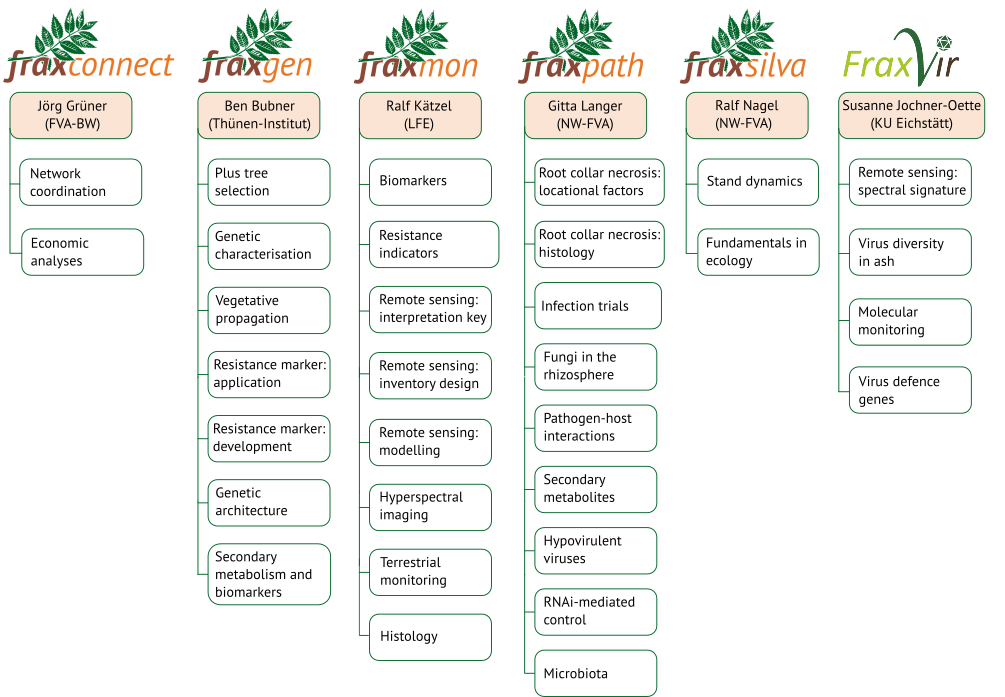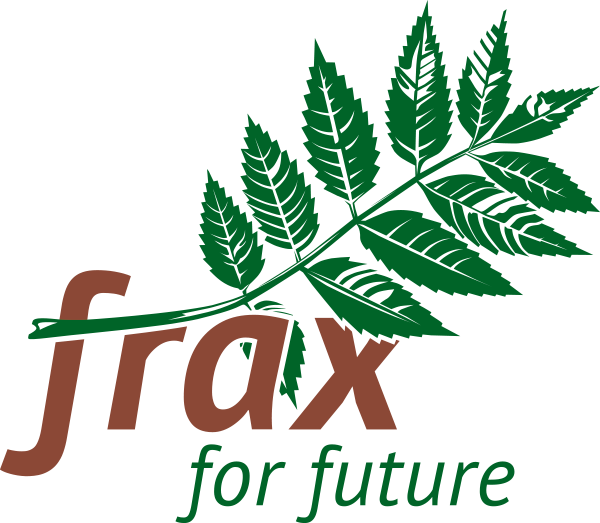
The FraxForFuture Research Network
The occurrence of the common ash (Fraxinus excelsior) in Central Europe is declining dramatically. The reason for this decline is the infection by the non-native fungus Hymenoscyphus fraxineus. Since 2002, it has caused ash dieback in Germany, as well as in large parts of Central Europe. Deterioration of wood quality, tree mortality, and rising expenses for disease controls and measures to address safety issues concerning infected trees has led to financial losses for landowners and forest enterprises. Once an economically valuable species, the future use of the common ash is highly uncertain, especially since investments into regenerating stands of ash trees are no longer recommended.
In order to ensure the preservation of ash trees as a native forest tree species and thus the preservation of adapted species and respective biological communities, the research network FraxForFuture was initiated. Study plots distributed all over Germany serve as a common working platform for scientific investigations based on a wide-ranging catalogue of methods. All participating institutions are working on these field study sites.
Five sub-networks, each consisting of several projects, have been established throughout Germany; accompanied by a complementary study. They address different research topics and work closely together to harvest synergies. More information about the project partners can be found here.
Goals
FraxForFuture will develop a national strategy for forestry, policy, and research for effective collaboration to preserve ash trees. In addition, this research network is the first of its kind in Germany to develop a coordinated approach to recording, describing and handling a forest disease, utilising ash dieback as a case study. The long-term preservation of ash as a commercial tree species, developing a deeper understanding of the disease, and determining the management of infected stands are the main focus of the project. FraxForFuture thus works both directly on ash dieback and in preparation for other anticipated far-reaching damages in forests, by establishing structures for effective nation-wide management of such events.
About the research network
FraxForFuture is designed as a demonstration project. This means that in addition to the immediate findings on ash dieback and forestry management, other important elements in the research process will be studied and evaluated. Specifically, for example, relevant and competent research partners will be identified in order to establish a transdisciplinary research network for addressing a complex research question. The challenge of establishing such a network will likely be faced by other researchers and research funding agencies in the future. Ash dieback, as a multifaceted forest disease, is hence exemplary for similarly extensive and anticipated research tasks.
Thus, it has to be clarified which technical competences are needed, who covers them in Germany, and into which sub-tasks a complex research question needs be broken down. The process of collaboration between these partners must be organised, structured and moderated - during the planning stage as well as during the actual research.
The five sub-networks
FraxConnect fullfills a dual function, (I) it ensures the communication and coordination of the entire FraxForFuture research network and (II) conducts economic analyses and is responsible for its transfer to practitioners.
In detail, these are the following tasks:
- Creation of a communication concept for the general public, forestry practitioners, political decision makers and the scientific community
- Organisation of internal scientific exchange and an international scientific conference
- Knowledge transfer: development of a web-based project portal, practical training, policy advice
- Contributions to silvicultural recommendations, strategy development, and economic analyses - decision-making and adaptation tools: development of a crisis manual
- Contributions to other sub-networks: Development of scoring keys for assessing ash tree health and vigor, participation in selection of plus trees
FraxGen focuses on the genetic aspects within the research project. The genetic variability of ash trees and fungal pathogens is being investigated. Another focus of this collaborative effort is the selection of plus trees. These are considered sustainable because they currently show no or hardly any disease symptoms and can be used as seed trees for establishing more resistance in subsequent generations.
- Identification of healthy and vigorous plus trees and their characterisation by means of molecular-genetic markers as well as determining diversity, stand and population structures of ash trees in Germany
- Investigation of genetic diversity and structure with regards to resistance and susceptibility of ash trees in Germany
- Generative propagation of selected plus trees as well as vegetative propagation by means of tamping, occulation and tissue culture; establishment of clone bank and seed orchards which can be used for the conservation of ash genetic resources, the provision of vital propagation material and for further breeding efforts
- Testing seedlings for susceptibility prior to planting by exposing them to increased infection pressure loads
- Identification of differentially expressed genes in resistant and susceptible ash genotypes to ash dieback and development of adaptive genetic markers; investigation of phenolic constituents as markers for possible resistance
FraxMon
FraxMon is dedicated to the monitoring of ash stands, i.e. the ongoing monitoring of disease development. In this way, this sub-network lays the foundations for management concepts and area-related considerations for dealing with ash as a commercial tree species.
- Establishment of a hierarchically structured monitoring network as a basis for
- objective risk analysis on the spatial and temporal dynamics of the spread of ash dieback,
- as a research platform for all field studies of the research project, and
- as a source for the selection of potentially resistant and tolerant ash trees (plus trees)
- Development and evaluation of monitoring methods for vitality diagnostics at different scale levels: stand-by-stand using aerial photo analysis, single tree using biochemical analyses of wood and leaf samples
- Development of remote sensing-based methods for application in large-scale detection of ash dieback
FraxPath
FraxPath investigates the relationships between ash as a host tree species and the pathogen H. fraxineus. The various symptoms of ash dieback (e.g. collar rots, shoot infections, leaf necrosis) are being explored and innovative approaches to pathogen management are being sought:
- Insights into pathogen-host interactions as well as associated secondary metabolites, the influence of site factors on development of collar rots and on ash microbiota; in particular, studies of the aetiology and infection pathway in collar rots and the role of the rhizosphere
- Comparison of transcriptomes of infected specimens of susceptible common ash and Manchurian ash (F. mandshurica), which has co-existed with the pathogen for a long time and has significantly less damage
- Identification of differentially expressed gene markers of H. fraxineus as an indication of possible resistance
- Options of pathogen control for H. fraxineus in the forest
FraxSilva
FraxSilva pursues different research approaches in natural environments (in situ) and outside of them (ex situ). The main objective is to test and develop silvicultural treatment options for practical use (forest owners and managers). The following approaches will be worked on:
- Identification of factors related to forest structure and stand treatment of established pure and mixed ash stands, which are correlated with lower damage of individual trees and stands (among others, based on long-term data sets from 30 experimental plots)
- Description and investigation of the ecological basis (in situ and ex situ) of ash dieback epidemiology under varying mixing types and mixing forms (including using artificial and natural foliage litter variation)
- Investigation of the establishment, growth and competitiveness of natural ash regeneration in mixed stands under the influence of ash dieback (among others, using experimentally initiated natural regeneration)
- Comparison of different possibilities for safeguarding and further development of stands severely damaged by ash dieback, including the affected residual stand and natural adaptation processes of ash populations (including on the basis of cultivation trials of alternative tree species)
- Review and revision of existing silvicultural recommendations for the treatment of stands damaged by ash dieback, incorporating the results from stages (1) to (4) as well as the findings of the other FraxForFuture research collaborations
FraxVir
FraxVir is a complementary study to the five sub-networks. Ash decline is usually related to the fungus H. fraxineus, but other factors can also affect the health of ash trees. Viral infections play a special role in this context. The interaction of viruses and fungi has been insufficiently researched so far. Four projects are therefore currently investigating how viral infections affect ash trees. More information can be found on the project website.
Funding
The FraxForFuture research network is funded by the German Federal Ministry of Food and Agriculture and the German Federal Ministry for the Environment, Nature Conservation and Nuclear Safety. The projects of the sub-networks are funded by the Waldklimafonds. The project executing agency is the Fachagentur für Nachwachsende Rohstoffe e.V..

